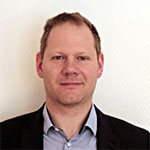 Dr. Michael Muskulus is an Associate Professor in the Department of Civil and Transport Engineering and Head of Offshore Wind Turbine Technology Group at the Norwegian University of Science and Technology. As the Science and Research topic leader for EWEA OFFSHORE 2015, he’s compiled a programme for two conference sessions full of the best and most advanced research on the offshore wind industry. We spoke with him about some of these technological innovations and the importance of collaboration among the industry, the EU and academia.
Dr. Michael Muskulus is an Associate Professor in the Department of Civil and Transport Engineering and Head of Offshore Wind Turbine Technology Group at the Norwegian University of Science and Technology. As the Science and Research topic leader for EWEA OFFSHORE 2015, he’s compiled a programme for two conference sessions full of the best and most advanced research on the offshore wind industry. We spoke with him about some of these technological innovations and the importance of collaboration among the industry, the EU and academia.
What important technological advances have been made in offshore wind technology in recent years?
In science & research we focus a lot on long-term objectives, and our developments can take some time before they impact current technology. That said, some of the more interesting developments in recent years seem to be in LiDAR [a remote sensing technology that can be used to increase energy output by measuring wind speed and turbulence], in controller design and related to hydrodynamic and geotechnical issues, for example in the design of very large monopiles. We have also seen a lot of testing going on lately, both with real turbines and in model scale, that result in important, novel data for improving the design and performance of wind turbines.
What developments are currently being worked on and when do you hope they will be ‘live’?
There is a lot of effort going into improving our numerical models, e.g. on the representation of the environment and its accuracy, which is important for offshore wind resource assessment and getting more realistic predictions of turbine loads, such as from turbulence and operation in wakes. Interesting work is being done on improving wind turbine control with real-time information about the environment (sometimes obtained from LiDAR technology) and on the wind farm level. A new focus area is the operational side, so we currently see a lot of important developments related to improving logistics of marine operations and maintenance of wind turbines.
What advances do we need to make to bring down the costs of offshore wind energy?
Reducing the cost of offshore wind energy is the central theme for most of us, but it is also a very complex issue. There is a tendency within most of us to reduce the complexity and simplify the problem as much as possible, but this is dangerous. What we need to do instead is to consider the problem in a holistic way that captures all the relevant effects – including manufacturing, logistics and maintenance costs in the design of wind farms, as well as market and financing aspects. As most of these effects contain an element of uncertainty, we need new probabilistic ways of assessing projects, technological developments and their risks, and we need the people that can properly understand these methods. Finally, we need the industry to work together and with us in academia much more than previously, if we want to see real improvements.
How important is EU funding and policy in supporting offshore science and research?
Funding initiatives established by the EU are very important in stimulating new developments, this is a simple fact. As this is a truly European industry that needs cooperation beyond national borders, there are limits to what national funding alone can accomplish. On the other hand, EU funding priorities, such as for floating technology during the EU’s FP7 research programme, have a slightly longer horizon than most companies have nowadays. I am also critical about the focus on industry participation and measurable success in terms of impact and relevance that EU projects require. There are some very interesting and important ideas that we cannot get funding for, since we cannot find industry partners to support these high-risk research activities. These issues are often too applied for basic research funding, however. In the past funding was more often available for an interesting idea alone. Although quite a lot of these projects would not be successful, the ones that were completely justify the funding decisions.
As chairperson of the science and research topic at EWEA OFFSHORE 2015, what do you hope participants will learn from the conference sessions?
It is my hope that participants of EWEA OFFSHORE 2015 will get an update on what is currently happening in science & research, and what could be interesting for them to look at in more detail or even collaborate on. When compiling the programme, we have tried to showcase the most important recent developments, and thanks to the high quality and volume of the submissions, we have come up with some very interesting sessions. I also hope that participants will use the opportunity to meet and discuss with the presenters in between and after the sessions.
What do you hope to gain from the EWEA OFFSHORE 2015 event?
Personally, I am looking forward to meet with many of my colleagues and peers at EWEA OFFSHORE 2015, to discuss present and future work, and possibly also establish some new projects. In the past, EWEA OFFSHORE conferences have always been a rather intensive and fruitful place, and I have often left stimulated and with a bag of new ideas. I hope to experience the same again in Copenhagen.
For more information on the Science and Research sessions and to view the rest of the EWEA OFFSHORE 2015 conference programme, click here.
Follow EWEA on: